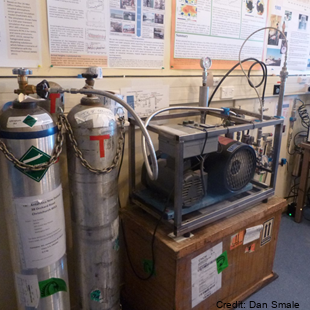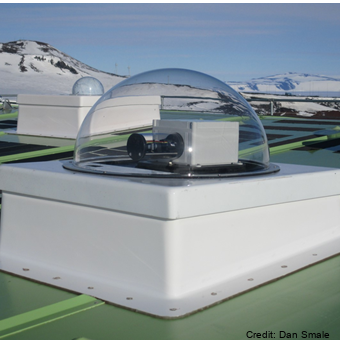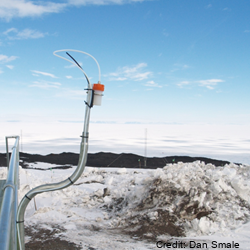annually
Type of resources
Topics
Keywords
Contact for the resource
Provided by
Years
Formats
Representation types
Update frequencies
status
Scale
Resolution
-

A semi-autonomous sea ice monitoring station (SIMS) was deployed to record ice temperature profiles and snow depths throughout the winter to late spring portion of the sea ice cover's growth season. These data were used to quantify the factors that govern the rate at which the sea ice grows. These factors include the local air temperature, vertical temperature gradient in the sea ice, the thickness of the overlying snow cover and the properties of the water column at the ice / water interface. The ice temperature profiles were recorded by a custom-built temperature probe designed by the University of Otago. The Otago thermistor probe consisted of twenty thermistors contained within a ~ 2.5 m long, 10 mm diameter stainless steel tube. The spacing of the thermistors in the probe was variable. This dataset provides information on the growth of the landfast sea ice and how much of this growth was due to heat loss to the atmosphere vs heat loss to the ocean. Locations: lat:-75.275700, lon:164.067300 (2022/23) Sea ice salinity and fabric cores were collected to understand sea ice growth rates, and indicate the different types of landfast sea ice (e.g. columnar versus incorporated platelet) and to determine their relative vertical positions with the sea ice cover. Sea ice, sub ice platelet layer, snow and freeboard measurements were used to validate ice thicknesses determined by analysing the sea ice temperature profiles collected by the SIMS. Snow depths were measured with a Campbell Scientific ultrasonic sensor (SR50). VIEW DATA: https://seaice.otago.ac.nz/ice-temp-graph/contour/
-

Gas samples (CO2, CH4, CO, N2O, 13CO2, 14CH4, 13CO, C18O, 14CO) are collected from an inlet atop of a mast 5 metres above ground level in North sector wind conditions. Flasks and cylinders are analysed back at NIWA Greta point Gaslab. The sampling was established in November 1989. Samples are only taken when wind is from the Northerly sector and above 5kts. High pressure cylinders: ~1600psi in 30 litre cylinders and low-pressure flask samples taken (~5 litres, 25 psi in 2 litre flask). Air samples in the Cylinders & Flasks shipped to New Zealand regularly. Analysis performed at NIWA's GASLAB located at Greta Point Wellington. Analysis by Gas chromatography (GC) and isotope ratio mass spectrometry (IRMS). A semi-automated flask sampling system was installed in February 2017, allowing extra flask samples with minimal operator intervention. GET DATA: Contact Gordon Brailsford (g.brailsford@niwa.co.nz)
-

Spectroscopic measurements of stratospheric gases Nitrogen Dioxide (NO2), Chlorine Dioxide (OCIO), Bromine Oxide (BrO) and Ozone (O3) using scattered sunlight. Airyx and Envimeas: A dual MAX-DOAS UV/visible wavelength diode array spectrometer is deployed to measure of ozone (O3), nitrogen dioxide (NO2), chlorine dioxide (OClO) and bromine oxide (BrO). The instrument is a similar instrument to that of EnviMeas, and produces overlapping datasets with ADAS-2. Fixed azimuth direction, same as the Antarctic Diode Array spectrometer. System 2 (ADAS-2). The data are currently being held internally by NIWA. “Raw” data are times and recorded spectra of scattered light for several viewing directions. “Derived” data are column amount of NO2, OClO, BrO and O3, which can be split into tropospheric and stratospheric parts. This technique is sometimes referred to as MAX-DOAS Multiple-Axis Dual Optical Absorption Spectrometry. This work is carried out in collaboration the University of Heidelberg. ADAS2, Envimeas and Airyx measurements: UV/visible Multi-Axis Differential Optical Absorption Spectroscopy (MAX-DOAS) diode array spectrometers making measurements of ozone (O3), nitrogen dioxide (NO2), chlorine dioxide (OClO) and bromine oxide (BrO). JY: A scanning grating UV/Vis monochromator taking measurements of total slant column of NO2 and Ozone using scattered zenith sunlight. ADAS: A CCD grating UV/Vis grating Acton spectrometer making measurements of total slant column NO2, BrO, OClO and ozone made using scattered light zenith sunlight. Pandora: Direct sun UV/Vis measurements of ozone and NO2. Campaign to test feasibility of long term deployment at Arrival Heights. Instrument timeline JY: 1982 -2023 ADAS: 1993 - 2017 ADAS2: 1998 - present Pandora: 2015 Aug – Oct. Airyx & Envimeas : 2018 – present O3, OCIO and BrO data are in the process of being archived - please contact Richard Querel for data access. NO2 data is available via the "GET DATA" link. GET DATA: https://www-air.larc.nasa.gov/missions/ndacc/data.html?station=arrival.heights
-

Measurements of total column of ozone made with Dobson spectrophotometer that measures either direct or zenith scattered ultraviolet light. The instrument was established in September of 1989 at 77° 49.8'S, 166° 39.6'E. Additionally a Brewer spectrophotometer took total column ozone measurements at Scott from 1989 to 1996. From 1989 to 2006 the Dobson (ID 17) was operated in manual mode but had an electronic encoder and computer added in 2006 for recording measurements. The data acquisition system was upgraded in Febuerary 2015 at Lauder, NZ. It is now running the JMA automation system. The Dobson (instrument ID: D17) is shipped out for maintenance and intercomparison with regional standard Dobson in Melbourne approximately every 5 years. Data (for both Dobson and Brewer) is held internally by NIWA and in the NDACC database. Data is also archived in the ozone and UV data centre Toronto, “Raw” data are times and instrument settings for instrument readings. “Derived” data are column amounts of ozone. Time line: Dobson 1987 -present Brewer 1989-1996 GET DATA: https://www-air.larc.nasa.gov/missions/ndacc/data.html?station=arrival.heights#
-

Measurements of boundary layer concentration of ozone are made with insitu instruments that samples air continuously at Arrival Heights, Antarctica and is part of the NOAA Global Monitoring Surface Ozone Network. Original measurements at Arrival Heights were made with a Dasibi Environmental Corp in situ analyser. This was replaced with a TEI-49c in situ analyser. The TEI-49c is owned by NOAA and operated by NIWA at Arrival Heights until October 2023. In October 2023 operation of the TEI was transferred to the USAP Arrival Heights laboratory along with operational responsibility (between NOAA and USAP). This data set contains continuous UV photometric data of surface level ozone collected at 6m above ground level. Data records consist of UTC time, date, and processed ozone mixing ratio (parts per billion). Data is collected from global locations and is provided in 1 minute and 1 hour averages. Data are archived at the NOAA National Climatic Data Center (NCDC), but are produced and available from NOAA Earth System Research Laboratory (ESRL). Instrument timeline: - Dasibi 1997-2003 - TEI49c 2003 – October 2023 - TEI49i November 2023 -present at USAP Arrival Heights laboratory GET DATA: https://gml.noaa.gov/aftp/data/ozwv/SurfaceOzone/ARH/
-

This dataset has been superseded by a new edition (3rd edition, 2020) available here: https://data.gns.cri.nz/metadata/srv/eng/catalog.search#/metadata/5F6780CB-4135-4204-A2C8-50DD74B0466F. This 2nd edition has been kept as a historical archive and is available on request.. This dataset is the annotation associated with the faults data for New Zealand. The dataset is a product of the QMAP Geological Map of New Zealand Project and was produced by GNS Science. At the time of publication it represented the most current mapping of faults for New Zealand in a single dataset at a scale of 1:250 000. The dataset is stored in an ESRI vector geodatabase and exported to ArcGIS Server. The dataset comprises annotation which stores the fault name.
-

This collection of datasets has been superseded by a new edition (3rd edition, 2020) available here: https://data.gns.cri.nz/metadata/srv/eng/catalog.search#/metadata/5F6780CB-4135-4204-A2C8-50DD74B0466F. This 2nd edition has been kept as a historical archive and is available on request. This collection of datasets contains the 1:250 000 geological data for New Zealand. These datasets are a product of the QMAP Geological Map of New Zealand Project and were produced by GNS Science. At the time of publication they represented the most current geological mapping of New Zealand at a scale of 1:250 000. The datasets are stored in an ESRI vector geodatabase and exported to ArcGIS Server. The data structure complies with the GeoSciML 4.1 standard, where one exists, and uses the relevant CGI Controlled Vocabularies. The mapping frame of the majority of datasets is defined as 'surface geology', but some are either 'base of overlying geology' or 'top of basement'. The data should not be used at scales beyond that for which it was prepared. The spatial accuracy is estimated to be no better than +/- 250 m.
-

This dataset has been superseded by a new edition (3rd edition, 2020) available here: https://data.gns.cri.nz/metadata/srv/eng/catalog.search#/metadata/5F6780CB-4135-4204-A2C8-50DD74B0466F. This 2nd edition has been kept as a historical archive and is available on request.. This dataset is the mineral metamorphic data for New Zealand. The dataset is a product of the QMAP Geological Map of New Zealand Project and was produced by GNS Science. At the time of publication it represented the most current mapping of mineral metamorphic polygons for New Zealand in a single dataset at a scale of 1:250 000. The dataset is stored in an ESRI vector geodatabase and exported to ArcGIS Server. The dataset comprises polygons with each polygon having attributes describing the mineral grade and age. The data structure complies with the GeoSciML 4.1 standard where relevant and uses the appropriate CGI Controlled Vocabularies. The mapping frame is defined as 'surface geology'. The data should not be used at scales beyond that for which it was prepared. The spatial accuracy is estimated to be no better than +/- 250 m.
-

This dataset has been superseded by a new edition (3rd edition, 2020) available here: https://data.gns.cri.nz/metadata/srv/eng/catalog.search#/metadata/5F6780CB-4135-4204-A2C8-50DD74B0466F. This 2nd edition has been kept as a historical archive and is available on request.. This dataset is the structural measurements data for New Zealand. The dataset is a product of the QMAP Geological Map of New Zealand Project and was produced by GNS Science. At the time of publication it represented the most current collection of structure data for New Zealand in a single dataset at a scale of 1:250 000. The dataset is stored in an ESRI vector geodatabase and exported to ArcGIS Server. The dataset comprises points with each point having attributes describing the type of structure, its dip and dip direction. The data structure complies with the GeoSciML 4.1 standard where relevant and uses the appropriate CGI Controlled Vocabularies. The mapping frame is defined as 'surface geology'. The data should not be used at scales beyond that for which it was prepared. The spatial accuracy is estimated to be no better than +/- 250 m.
-

This dataset has been superseded by a new edition (3rd edition, 2020) available here: https://data.gns.cri.nz/metadata/srv/eng/catalog.search#/metadata/5F6780CB-4135-4204-A2C8-50DD74B0466F. This 2nd edition has been kept as a historical archive and is available on request.. This dataset is the annotation associated with the resources data for New Zealand. The dataset is a product of the QMAP Geological Map of New Zealand Project and was produced by GNS Science. The dataset is stored in an ESRI vector geodatabase and exported to ArcGIS Server. The dataset comprises annotation which stores the commodity extracted at the site.
 GeoData.NZ
GeoData.NZ